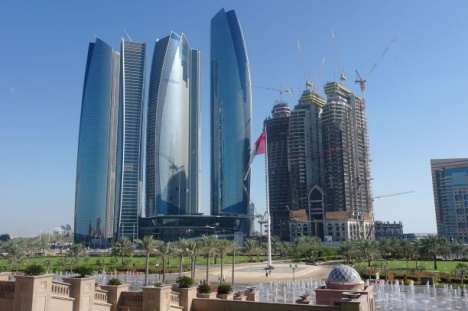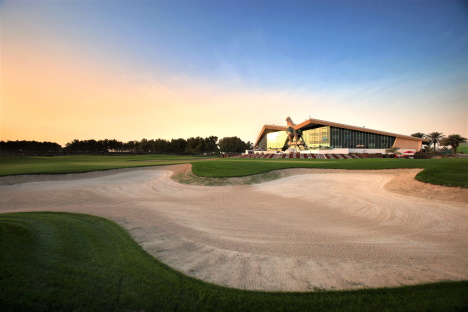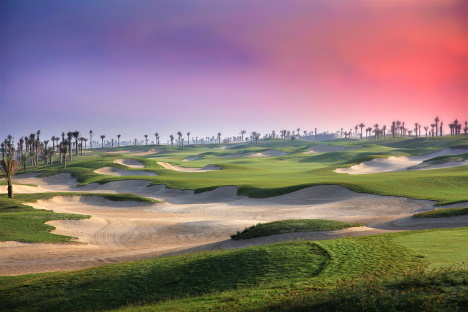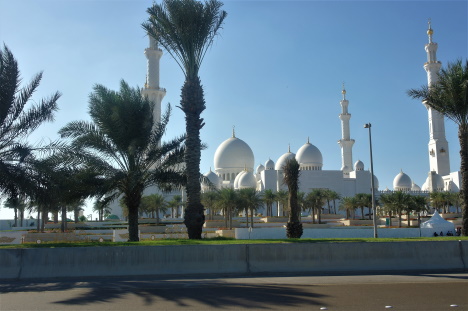|
|
Tilbake
til første side Debattsiden
Golfreiser

Abu Dhabi Saadiyat Beach Golf Club
02.06 Golfreiser:
2020 Abu Dhabi – The Desert Diamond
Text: Louis Røren Photos: Resorts and
Louis Røren
In December 2011 I visited Abu Dhabi for the
second time, where after I filed a report headlined The Desert Diamond. I am
re-using the headline, though not without some hesitation as will be explained
in the following.
The simple way it presented itself then, in contrast to its ostentatious
neighbour Dubai, the ease of navigating its main city and surroundings, and its
ambitious plans of developing one more of the emirate’s sand banks, all seemed
rather agreeable and pleasing. As a visiting golf travel writer this included
naturally a review of its golf courses, of which two were fairly new, all being
of the highest standard.

Abu Dhabi byr på en noe spesiell sky line.
Before proceeding I would however like to take the readers back a few years,
till the time when modern day Abu Dhabi came into being. And we do not have to
go far back, only some 60 years. At that time was Abu Dhabi a poor and
undeveloped desert state in the Arabian Gulf. The coastline consisted of
scattered sand banks and the rest was all desert. Its inhabitants were tribal
nomads subsisting on pearl diving, fishing, deer hunting and to some degree
trading with its neighbouring states. Hunting was always done with the
assistance of falcons, and a falcon is today the national symbol. The daily
staple consisted of dates, dried meat and fish, and the only means of
transportation was by camels. Then, in 1958, its first oil deposits were
discovered, and more and more in the following few years. Thus, from being one
of the world’s poorest states, it soon was to become one of its wealthiest.

Abu Dhabi Golf Club - klubbhus
Today Abu Dhabi is the largest and leading emirate of the seven emirates
constituting UAE – United Arab Emirates – of which Dubai is but one. And up
until the turn of the 21st century it was Dubai stealing all the thunder through
its spectacular development projects, which continues till this day, albeit not
without hitches along the way. But where Dubai developed without any visible
planning or boundaries, Abu Dhabi developed through a more planned and academic
approach. By hiring the best known urban developers and architects Abu Dhabi
hatched a plan named Abu Dhabi 2030. And from what I could see during my last
visit the emirate seems to be well on its way to realizing its ambitions, albeit
with certain modifications along the way. This does not mean that Abu Dhabi will
not have its share of exotic, spectacular and some of the ‘largest and only’
projects. Sure it will. And some like The Sheik Zayed Grand Mosque and Emirates
Palace Hotel (where everything that looks like gold is gold, inclusive of the
gold sprinkle on the ice cream) are only two examples.
The comparison with Dubai is unavoidable. But where Abu Dhabi was blessed with
immense sand banks, some now turned into fully developed and inhabited islands,
Dubai has had to create its own islands in the mindblowing form of The Palm and
The World amongst others due to its coastline simply being a multi mile long and
straight stretch of beach, broken only by Dubai Creek, a kind of natural harbour
canal stretching 1,5 km inland from the old town of Dubai.

Saadiyat Golf Club
Saadiyat Island
The city of Abu Dhabi actually lies on one of the former sand banks, and two of
the sand banks nearest to the city are now central parts of Abu Dhabi future
developments. Especially the closest, Saadiyat Island, is of particular
interest. Saadiyat Island is assigned to become the cultural - and sports centre
of the emirate with spectacular museum buildings named Louvre and Guggenheimer,
according to special agreements with the respective museums in Paris and New
York. Additionally will be built a National Museum, a Maritime Museum, concert
halls, hotels, sports facilities (like a few more golf courses) and housing for
about 150.000 residents. In December 2011 during my second visit most of this
was visible only as an elaborate model, apart from one golf course and two
hotels already in existence. And to get to the island from the city island you
had to traverse (by today’s standards) a rather primitive wooden bridge. Today
you will enter Saadiyat Island through an elaborate tunnel and bridge system
that definitely requires a sophisticated SatNav system to negotiate. Even then
there will be plenty of room for mistakes. During my last visit The Louvre of
Abu Dhabi was opened (and visited), a few other structures of unknown identity
were also completed, as were several more hotels (all the major world-known top
brands seem to be present). Heaps of residences were built, particularly along
the golf courses and their vicinity. But more than the buildings it was the road
systems that were the most impressive and overwhelming, clear signs of what is
to come as developments continue.

Saadiyat Golf Club - hull 15
Yas Island
The neighbouring island, Yas Island, is assigned to become the emirate’s
playground.
0620.jpg)
Yas Links - hull 12
By 2010 there was already built the world largest indoor amusement
park sponsored by Ferrari, Ferrari World, a Formula1 car race track, a good
number of hotels, an enormous marina --- and the Yas Golf Links course, arguably
the best golf course in the Middle East. And there is no denying that Yas Island
has become an enormous success with the population in the area.
A world class golf destination
An integrated part of Abu Dhabi’s 2030 development plan was the development of
some 20 golf courses. By 2020 six courses are already on offer within the
emirate. Two of the courses are considered more for local consumption; a decent
9 hole course near the centre of Abu Dhabi city, and a non-grass golf course
near its international airport. A decent 18-holer is located in the inland city
of Al Ain. Hence for short term visitors to Abu Dhabi I consider only three
courses to be of interest, three courses that are of the highest international
standard in all aspects. They are all very different, representing a variety
that ought to satisfy any golfer. Dubai was in 2008 bestowed the honour of being
named ‘Golf destination of the year’ for MiddleEast and Africa by IAGTO
(International Association of Golf Tour Operators). In 2012 it was Abu Dhabi’s
turn to be named. And whilst there may be a few more golf courses in Dubai the
local Golf Digest as early as 2011 voted the 3 top courses in Abu Dhabi amongst
the 4 top courses in the region.
Abu Dhabi Golf Course
As previously mentioned a falcon is Abu Dhabi’s national symbol. Nowhere is this
more visible than on top of the club house of Abu Dhabi Golf Club. Abu Dhabi GC
is the grand old lady of golf in the emirate. The course opened in 1998,
designed by the recognized British course designer Peter Harradine with some 180
courses worldwide to his name, and the Abu Dhabi GC may arguably be his best. In
any case it has become an institution being the season opening venue for the
European Tour since 2006. Anyone watching TV transmissions from this event
cannot but be struck by the imposing, gold clad falcon overlooking the 18th
green. The course itself plays over a rather flat and uninspiring landscape
which makes for an easy walk if so desired (depends on the heat of the day). It
always presents itself beautifully with flowerbeds and palm trees at strategic
points. The layout seems to this writer to be a perfect tournament course with
rather narrow fairways, rounded, shallow bunkers and seemingly flat greens with
some subtle but wickedly sharp breaks. Water also comes into play on 7 of the
course’s holes. Next to the clubhouse you will find the 5* Westin Abu Dhabi
Hotel with all amenities conceivable. In the back of the hotel, next to the golf
course, you will be overlooking one of the best golf practise areas you will
find anywhere, floodlit at night, as is a super 9 hole golfcourse on the
opposite side from the main course. It is not without merits that many claim
this to be the best golf resort in the Middle East.
Or as its marketing spin so precisely has it *An oasis of tranquillity carved
out of the desert*.

Saadiyat Beach Golf Club
Saadiyat Beach Golf Club
It would take another 12 years before the next two golf courses opened in Abu
Dhabi. A time that must have seemed like an eternity in a country that saw
electricity and paved roads only some 50 years earlier. One of these courses is
Saadiyat Beach Golf Club, designed by the famed South African Gary Player, and
placed on the cultural island of Saadiyat. I have rarely seen so much sand in
play on any other course, even in Arizona, an intriguing blend of seaside and
desert course. Six of the holes are running alongside the beaches of the Arabian
Gulf, the rest are inland behind the front rows of luxury hotels having
been/being built. The beguiling turquoise sea is visible from basically all the
holes. My guesstimate of the sandy and the turf playing areas would be like 40%
sand and 60% turf. Whilst many of the sandy areas are so called ‘waste bunkers’,
equally much or many of them are indeed bunkers. To those harbouring aversions
for bunkers this course must look nightmarish, but I assure you, the beauty of
it and its surroundings will alleviate any such fears. And the near vicinity to
the sea will tempt you to dive in more than once during the round.
Gary Player’s signature is that he often gives golf holes descriptive names, so
also on this course. Hole no 1 is named Prelude, Hole 2 Split personality (split
fairway), hole 5 Dolphin view, hole 15 double trouble (crossing water hazards
twice) to mention a few, which I find to be rather amusing. Already during my
first visit to this course it became one of my favourite courses anywhere, as
reaffirmed during my last visit.

Det 13. hullet på Yas Links
Yas Links Golf Club
Yas Links golf Course also opened in 2010, and instantly became a world wide hit
within the golfing fraternity. Designed by Kyle Phillips (Kingsbarns in
Scotland, The Grove in England to name a couple), a prodigy of Robert Trent
Jones Jr. Here he has created a links style course out of a flat sand bank,
hitherto unseen in the Middle East. Though it is built on sandy soil there are
no real sand dunes impacting the landscape. But apart from that this is a
serious linksy golf course that I believe even the most avid links aficionado
will be content playing. Nine holes are being playing alongside the sea/laguna
with the balance 9 on the inside with a natural flow of the routing. Rarely have
I played a golf course in better condition than here. And the bright green grass
contrasting with the turquoise coloured water outside left an indelible
impression of beauty and serenity, despite the noise emanating at times from the
Formula1 race track placed only a good drive and a pitch away from the course.
All three aforementioned golf courses are now (Yas Links being a recent
addition) being managed by Troon Golf which is the preeminent golf course
operator/manager in the world, and this should be the best guarantee for optimal
playing conditions at all times.
I started this article stating that I am somewhat hesitant in describing the
2020 Abu Dhabi as a Desert Diamond. The reason for being hesitant has nothing to
do with the emirate’s golf offering, which in all respects is superb, it has
more to do with what I now perceive as the area having lost some its ‘small
town’ charm. This time I simply felt overwhelmed by the ongoing constructions
and enormous road systems being built, seemingly all dimensioned to comply with
the emirate’s development plan AbuDhabi 2030.
Go visiting before it becomes a mirror image of Dubai.

Sheik Zayed Grand Mosque
|
|
|
|
|
|
